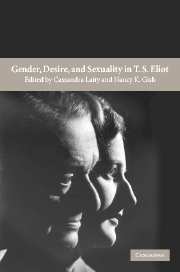Book contents
- Frontmatter
- Contents
- Acknowledgments
- Notes on contributors
- Introduction: Eliot, gender, and modernity
- Part I HOMOEROTICISMS
- Part II DESIRE
- Part III MODERN WOMEN
- Chapter 8 Through schoolhouse windows: women, the academy, and T. S. Eliot
- Chapter 9 T. S. Eliot speaks the body: the privileging of female discourse in Murder in the Cathedral and The Cocktail Party
- Chapter 10 T. S. Eliot, women, and democracy
- Chapter 11 Vipers, viragos, and spiritual rebels: women in T. S. Eliot's Christian society plays
- Index
Chapter 8 - Through schoolhouse windows: women, the academy, and T. S. Eliot
Published online by Cambridge University Press: 22 September 2009
- Frontmatter
- Contents
- Acknowledgments
- Notes on contributors
- Introduction: Eliot, gender, and modernity
- Part I HOMOEROTICISMS
- Part II DESIRE
- Part III MODERN WOMEN
- Chapter 8 Through schoolhouse windows: women, the academy, and T. S. Eliot
- Chapter 9 T. S. Eliot speaks the body: the privileging of female discourse in Murder in the Cathedral and The Cocktail Party
- Chapter 10 T. S. Eliot, women, and democracy
- Chapter 11 Vipers, viragos, and spiritual rebels: women in T. S. Eliot's Christian society plays
- Index
Summary
From the vantage point of the twenty-first century, the trajectory of Eliot's career in the twentieth appears to have two major stages: a long, high ride for forty years, with a few significant but impermanent dips, followed by a precipitous decline in the last forty. The present volume suggests the possibility of a correction to the decline – or at least a rekindled interest. Not coincidentally, this revival occurs as critics have become less sure of the usefulness of meta-narratives about modernism and more inclined to interrogate the components of the big story: might it not be more accurate to consider multiple modernisms? T. S. Eliot has been central to every phase of the project of modernist scholarship. An adjustable model of the modern artist, he seems capable of accommodating decades of incommensurable assessments. Since, as Eliot himself expected, these reconfigurations are inevitable, their origins and effects should themselves be objects of study. What makes a critical assessment plausible, even compelling, for one generation and unconvincing for another? Putting aside the obvious (and rare) cases like a new piece of evidence or a previously undiscovered manuscript, what forces power the hydraulics of literary reputation? Contrary to the maxim, there is a way of accounting for taste – indeed multiple ways.
This essay undertakes one piece of what must be a complex accounting – Eliot's reception among female readers in the context of women and their place (or lack thereof) in the academy.
- Type
- Chapter
- Information
- Gender, Desire, and Sexuality in T. S. Eliot , pp. 175 - 194Publisher: Cambridge University PressPrint publication year: 2004



